Combination Cancer Immunotherapy — A Virtual Roundtable: Part III

By Wayne Koberstein, Executive Editor, Life Science Leader
Follow Me On Twitter @WayneKoberstein
Llew Keltner, M.D., Ph.D., Roundtable Moderator
A series on the challenges and opportunities of using new agents to rally the immune system against cancer.
PART THREE: Companies At Stake

We are all partners. Life is partnership — life and death. As individuals cast at birth into a vast net, we habitually ignore this web of connections as mere background, but it is always there, whether we cooperate or struggle against it. Like greatness, some people and the organizations they build seek alliances as the very stuff of life. Others have partnering thrust upon them.
With the new rise of cancer immunotherapy, the use of combinations is an emerging paradigm that demands a new kind of collaboration among all the key players, from key opinion leaders to companies to regulators to payers. What looks like competition between immuno-oncology mechanisms and therapies is that and more. Everyone wants a place in the ideal combination, but to get there, each one must collaborate with the others, if only in conversation and debate.
Our series of virtual roundtable discussions on combination cancer immunotherapy enters a new phase with this installment. Part Three moves from the KOLs in the first two parts to the leaders of companies developing advanced cancer immunotherapies and all vying for a place in the coming combinations. One of our goals was to compare the views of KOLs and companies by enlisting both groups in the roundtable panel and posing essentially the same set of questions to everyone.
In this part and continuing in Part Four next month, we will hear from the leaders of many key companies in the field. Their stake in the race — or is it partnership? — consists of capital, real assets, and other forms of value, including people, knowledge, and a genuine desire to change the ugly visage of cancer. In many ways, each one’s fate depends on what it does not only to compete against but also to cooperate with the other contenders.
We have changed the roundtable format here, from the question-by-question KOL discussion in Parts One and Two, to a company-by-company presentation — a necessity, given the high number of responding companies. We did our best to invite and include all of the companies now developing cancer immunotherapies, chiefly in the new areas generating the most excitement in the oncology community: checkpoint inhibitors, co-stimulators, and complementary immunostimulators such as cancer vaccines and ablative modalities that promote immune-cell production. We also hear from a few companies that believe other approaches deserve a place among the possible cancer immunotherapy combinations the roundtable addresses.
The questions we asked the panelists were as follows:
Why combinations?
Do you believe cancer immunotherapies should be used in combinations rather than as single agents, or is it possible to envision a single effective immunotherapeutic agent?
Essential components?
In your opinion, if cancer immunotherapy combinations are essential, what are the essential constituents of any combination therapy?
Backbone therapy?
Will a particular approach such as PD-1/ PD-L1 be the “backbone” of cancer immunotherapy combinations? Or will consensus on a hierarchy of therapies continue to evolve with the growth of scientific understanding in ongoing research?
Combo criteria?
By what criteria will physicians select specific immunotherapy combinations for individual patients or patient groups? Or will regulatory and reimbursement realities dictate the combinations?
Narrow or wide applications?
Will the most effective immunotherapy combinations be specific to traditional cancer indications (NSCLC, HCC, etc.) or tend to have general effectiveness against all or a wide range of cancers?
Personal or broad?
Do you see limits on the practice model for cancer immunotherapies; i.e., will cellbased approaches remain restricted to a small number of patients in intensivecare or salvage settings?
Commercialization challenges?
What are some of the major hurdles you face in commercializing your cancer immunotherapy product or products, especially considering the science, regulatory pathway, and market are still evolving?
General comment?
Is there anything else that you believe is critical to understanding how combination immunotherapy or another immunotherapeutic approach will move into use as the backbone of cancer therapy?
The following are the responses:
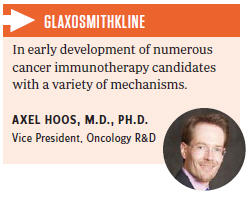 Why combinations?
Why combinations?
Some immunotherapies have proven effective as single agents. They have not yet been maximized in their benefit for patients. Combinations may maximize benefit and potentially enable cure.
Essential components?
Aim for synergistic pathways. Three main categories: 1) checkpoint modulators with each other to minimize immune suppression; 2) checkpoint modulators with other immunotherapies to reduce immune suppression and specifically activate immune responses; 3) immunotherapies with targeted therapies to leverage immune effects and targeted therapy effects (e.g., speed of effect, debulking, immune modulation, etc.).
Backbone therapy?
In the short term PD-1/PDL-1 and other checkpoint modulators, as they become available, will be the backbone of immunotherapy combinations based on their clinical efficacy and safety profile and their universal utility. With further evolution of other immunotherapy modalities, this may shift slowly based on the demonstrated effects.
Combo criteria?
If approved and reimbursed, immunotherapies will be selected for combinations based on their clinical benefit/ risk profile in the respective population. Research addresses rational combination possibilities based on mechanistic synergies and characterization of immune effects of non-immunotherapy combination candidates.
Narrow or wide applications?
A wide range of benefits is possible depending on the combination; e.g., for targeted therapy/immunotherapy combinations, most limitations are imposed by the targeted therapy. However, current development practices dictate development in histology-defined indications. With demonstration of wide benefit across boundaries of histology, it may be possible to modify these standards over time.
Personal or broad?
Immunotherapies should be as broadly accessible to patients as possible. However, limitations will be imposed by practicalities such as antigen expression, scalability of the approach, effect size, alternative options, etc. For cell-based approaches limitations may be greater than for more generic approaches.
Commercialization challenges?
Assuming we generate the needed clinical data on benefit/risk for any given immunotherapy or combination, the main challenges will be pricing and patient access. Particularly for combinations, the current pricing model will lead to very high costs for reimbursement agencies and may be prohibitive in some geographies. Building a new pricing model for combinations should improve this situation. For example, one could envision pricing a novel-novel combination as a regimen and not as individual drugs, thus introducing substantial discounts relative to individual pricing. The industry would benefit from working together to introduce new pricing models.
General comment?
Collaboration is going to be paramount to maximize value and speed to make combinations with immunotherapies a reality. Trends toward that are visible across the industry. Further, the evolution of an immunotherapy-focused clinical development and regulatory paradigm, which was started by the Cancer Immunotherapy Consortium (CIC) about a decade ago, will further increase the probability of success for new therapies.
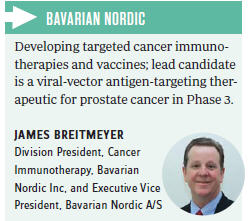 Why combinations?
Why combinations?
Although a single effective immunotherapeutic agent no doubt exists, there is also great promise for taking existing and future agents into combinations. A single agent would have to have three essential actions: targeting the immune system toward the tumor, potently stimulating a positive immune response, and overcoming the natural resistance to the immune system many tumors express in their microenvironment. We are testing our poxvirus-based cancer immunotherapies alone and with a variety of immune checkpoint inhibitors, and are generating some very exciting single agent and combination data, both in animal models and clinical trials.
Backbone therapy?
The very impressive efficacy results coming in with PD-1/PDL-1 antibody blockade suggest that immune checkpoint inhibition may be central to cancer immunotherapy. However, one potential disadvantage to using immune checkpoint inhibition alone is its autoimmune side effects, reported to involve variably skin, lungs, the gastrointestinal system, and the endocrine organs. Further, some patients respond fabulously, but others do not. Patients who cannot mount an endogenous T cell immune response will not respond to checkpoint inhibition and must have their immune system specifically activated and directed toward their tumor. Active cancer immunotherapy using tumor antigens presented as proteins or as viral or DNA vectors may fill this gap. Such combination therapy may also address the nonspecific autoimmune effects of checkpoint inhibitors by focusing the patients’ immune response on the tumor rather than on normal tissues.
Combo criteria?
In principle, each person’s immune system has the potential to become educated to recognize the tumor and suppress its growth with productive immunity. The timing to achieve effective anticancer immunity may depend on the combination deployed. We will know better how to configure combinations as people become more educated about immunotherapy and the old treatment paradigms melt away. In the studies that won its approval, ipilimumab improved overall survival in melanoma patients without a significant effect on progression, something oncologists do not normally see. Many immunotherapies produce delayed responses, and sometimes patients even show shrinkage or response of their tumor at some point after the immunotherapy has been completed. We hypothesize that targeted activation of an antitumor immune response (foot on the gas pedal) coupled with blocking immune suppression (foot off the brakes) has the potential for synergistic clinical benefit in a broad population of cancer patients.
Personal or broad?
Active immunotherapies for cancer are generally very well-tolerated, with side effects more like vaccines than other traditional anti-cancer therapies such as chemotherapy or radiation. This suggests they may be broadly applicable and given at some point to many cancer patients. Some therapies, such as those that require the patient’s cells to be harvested and processed outside the body, may have more limited applications.
Commercialization challenges?
Targeted therapies and immunotherapies will likely be pricey at first because they are complicated to develop in the laboratory and require a fullblown clinical development program. Immunotherapies will initially be used in a focused way; not everyone will get immunotherapy in the early days, at least. Payers will worry about combinations of expensive treatments, and they have few precedents for how to keep their overall system costs in control. There will be scrutiny and demands for good, solid clinical data to support reimbursement decisions.
There is skepticism about the viability of some kinds of immunotherapy in general, and particularly in the investor world. Anti-PD-1/PD-L1 success has become a lightning rod, and it seems everyone is scrambling to buy the next checkpoint antibody, push it into the clinic faster, or try for breakthrough designation. But in other areas, such as active immunotherapy or cancer vaccines, there is still skepticism, particularly among investors and potential commercial partners. Another hurdle is that some physicians and investigators understand how immunotherapy may be different from chemotherapy, hormone therapy, or radiation; others do not. The knowledge base around immuno-oncology for cancer therapy is expanding exponentially as more clinicians treat patients with this novel treatment paradigm.
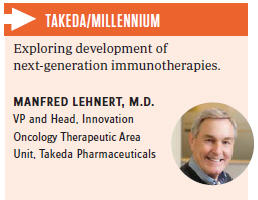 Why combinations?
Why combinations?
The major benefit of single agents has been limited to a subset of 20-40 percent of patients in certain diseases. There is a strong mechanistic rationale for combinations, and there is preclinical and early clinical data to support that.
Essential components?
At this point, anti-PD-1 or anti-PD-L1 would seem the backbone of clinical combination development. But this may well change in the future, when we better understand the clinical activity and safety profile of the many other agents and approaches that are in development. It may well be that optimal immune-therapy combination will depend on disease context (disease type and/or stage), and may be guided by molecular information from tissue (tumor and/or adjacent normal) and/or blood.
Combo criteria?
This will be largely driven by a mechanistic and scientific rationale and differential clinical benefits. It would seem inconceivable that oncologists may consider combining individual immune-therapeutics in routine clinical practice without robust benefit-risk evidence from well conducted clinical trials.
Personal or broad?
It seems likely that these two general approaches are not mutually exclusive, and each will play an important role in the same or different diseases.
General comment?
The field of therapeutic cancer vaccines has remained largely unsuccessful to date. But this may change through improved vaccine technology, personalization of vaccine therapy, and perhaps most importantly, concomitant or sequential combination with therapies that break immune tolerance.
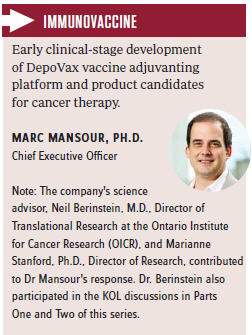 Essential combination components?
Essential combination components?
We need at least two components to “drive” effective cancer immunotherapies: We need a therapy, such as an effective cancer vaccine, to “push the accelerator,” or facilitate anti-tumor immune responses, and a component to “release the brakes,” or limit the immune suppressive forces that impair generation or effectiveness of the anti-tumor responses. Thus, we need to generate or provide effective tumor-specific T cells and also provide active but safe immunomodulators such as checkpoint inhibitors.
Combo criteria?
Ideally, specific immunotherapy combinations will eventually be selected based upon the patient’s tumor-expression profile and immune status. Initially, we will likely select treatments based upon data from trials that demonstrate the effectiveness of certain immune therapies and combinations in specific tumor cancer types and tumor stages. The biologic differences between tumor types and stages of tumor progression will prevent extrapolation into additional clinical indications without the relevant trials. Regulatory authorities will likely take this perspective until proven otherwise.
Personal or broad?
There are many types of personalized medicine used in clinical practice today, including surgery and autologous or allogeneic transplantation. Thus, it is likely that effective cell therapy or other immune therapies will be made available clinically. The more significant concern is how to reduce toxicities, particularly in early, high-risk clinical situations where risk of recurrence is high but the patient only presents microscopic disease. We need well-tolerated therapies, and off-the-shelf combination therapies will likely be more applicable than cell-based therapies such as CAR.
Commercialization challenges?
The evolving science in cancer immunotherapy has a significant impact on clinical trial design, particularly in the areas of analysis of clinical responses and the appropriate selection of patients to enroll in trials. We must identify the optimal immune modulators and immune-modulator combinations for the clinical indication being addressed. The issue of clinical responses to immunotherapy has been partially addressed through the irRC, or immune related RECIST criteria, but the uptake of irRC in pivotal trials has been slow. Preliminary data has also indicated that biomarkers and genetic signatures may be used to identify the patient population that will best respond to treatment, but validation of the biomarkers for selection has yet to be confirmed in the clinic.
General comment?
We highly value our preclinical data as a driver for clinical programs. We believe that well-conducted studies may help with the rational design of combination therapies and can assist in the appropriate design of clinical trials. Having said that, demonstrating a mechanism of action for the therapy in patients early on is critical to justify further development. This will allow for more efficient, effective, and innovative clinical trial designs that will translate into effective cancer therapies.
 Why combinations?
Why combinations?
[BRADLEY] We believe in combinations and have a robust clinical portfolio with CTLA-4, PD-1, PD-L1, and OX40 in development both as monotherapy and in combinations. The next wave of combinations for us is not just immunostimulators and checkpoint inhibitors, not just the gas on and brakes off. We are looking at the tumor microenvironment and promoting the enhancement of tumor antigen presentation, so we are focused not only on the adaptive immune system but also the innate system.
Essential components?
[SEETO] Everything is driven by the science, and we need to conduct more experiments to understand the essential combination components. Dr. Yong-Jun Liu, our new head of research, is a world leader in the field of immuno-oncology, so in addition to our focus on combinations, he has brought a whole new way of thinking about how we approach combination therapy.
Backbone therapy?
[BRADLEY] Obviously, the cornerstone of our immunotherapy strategy is combinations, and in those combinations there will be certain backbone approaches, but the optimal combinations are still being determined, and that is why there is so much activity at the moment to identify them. Still, although there is a great deal of talk about the second wave of immunotherapy, the therapies that are in the lead today will likely be the backbone therapies for optimal combinations for a long time.
Mark Mansour, PH.D, Chief Executive Officer
Commercialization challenges?
[JALLAL] There are no significant differences in the challenges for immunotherapies and other types of cancer drugs. We deal with several stakeholders. The first one is the patient — we must make sure whatever we do is backed up with data. If we say our drug should be used in a combination, the use must bring more benefit to patients. The second stakeholder is regulatory authorities, such as the FDA. We must deliver data that supports putting the combination use on our label. The third stakeholder is the payer, to whom we must also show data that differentiates our treatment in combination, plus cost-effectiveness data. We are right on track with our stakeholders in all respects right now.
Obviously, there are more complications if the combination includes not only our drugs but also ones from other companies. However, we have a broad portfolio, and most of the combinations we are developing now consist of molecules we have in house, and that gives us more flexibility and control over how we can price the combinations. We don’t develop drugs just for the sake of developing them — we want patients to have access to them. You have to work with all the stakeholders to make sure as many patients as possible can gain access to your drug.
[BRADLEY] Another consideration: Immune-mediated therapies take time to generate the immune cells that travel to tumor sites and kill cancer cells. Sometimes the biological effects take weeks to months. Physicians must realize there is a different pace of response, and the tumor may even seem to get a little larger at first, due to an inflammatory response, but it will then shrink and sometimes go away. What is surprising is how quickly physicians have, in fact, learned to deal with some of the differences in side effects.
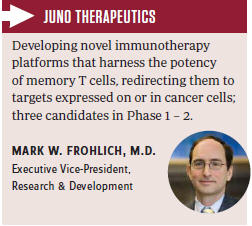 Why combinations?
Why combinations?
Historically, combination therapy with traditional agents has been the cornerstone of oncology. With novel immunotherapeutics, and an increased understanding of mechanism of action, there has never been a stronger rationale for combining drugs. In the short term, we need to combine drugs with potentially synergistic mechanisms. In the longer term, we can potentially combine multiple therapeutic avenues within our engineered T cells by modulating pathways within the T cells or using them as a vehicle to deliver molecules to the tumor micro-environment. For example, cytokines that would be toxic when delivered systemically could be delivered to the tumor by the T cells to provide potentially synergistic, or at least additive, anti-tumor effects.
Essential components?
Engineered T cell therapy and checkpoint blockade are two of the most exciting approaches. Checkpoint inhibitors are already approved for certain indications; they don’t appear to be working in all tumor types or patients but will be an important building block with which we can start mixing and matching in rational combinations. Used together, taking the brakes off and pushing the accelerator —providing cells specifically activated to target the cancer — will be important to test, particularly in the challenging solid tumor setting.
Backbone therapy?
Engineered T cells and checkpoints inhibitors can potentially serve as therapeutic backbones. However, earlier in the treatment paradigm, as in the adjuvant setting where only microscopic amounts of tumor remain, there may be insufficient antigen to stimulate a T cell response to a checkpoint inhibitor or to stimulate the proliferation of engineered antigen-specific T cells. In those settings, a vaccine to simulate T cell proliferation may be important as one of the therapeutic backbones in combination with the others.
Combo criteria?
Biologic rationale based on the mechanisms of action will be used to prioritize testing of combinations. Preclinical models may provide additional insights, but ultimately, combinations will need to be tested empirically in the clinic.
Narrow or wide applications?
Initial approvals will be in advanced patients with relatively narrow indications based on single arm trials in some cases. Subsequent confirmatory trials earlier in the treatment paradigm will be randomized and address larger patient populations. If dramatic anti-tumor effects with clear clinical benefit are observed in individual patients, then we can anticipate that cohorts of patients in smaller indications could be sufficient for label expansion or at least reimbursement.
Personal or broad?
Initially, combinations will be tested on groups of patients rather than on individuals. By appropriately investing in biomarkers that can help predict which patients are benefiting, we will have the opportunity to tailor the agent or combination to a particular patient. Some of the pathways or immune mechanisms are common across various disease types, and it is possible to imagine moving towards a paradigm where we screen patients for a biomarker and treat them based on the biomarker, as opposed to whether they have a particular cancer type.
Commercialization challenges?
Historically, companies have been hesitant to let their drugs be tested in combinations prior to obtaining regulatory approval. That appears to be changing, and we are seeing several companies partner on combination studies early in the drug development process. Regulators also are more receptive to new approaches to bringing combinations to market. Cost of goods will need to be controlled with novel biologic therapies, but the increased clinical benefit that can potentially be provided by these approaches should still translate to value for patients and payers.
We have run as many company responses as space allows this month and will follow with the remainder next month and beyond if needed to follow this rich vein of lessons in translational R&D, business development, scale-up, and commercialization of breakthrough medicines. We are still open to hearing from other companies that either missed our first invitation or believe they belong in the conversation. Meanwhile, please join the discussion on Twitter at #CCIRLSL.
